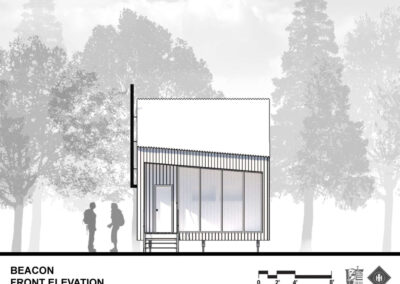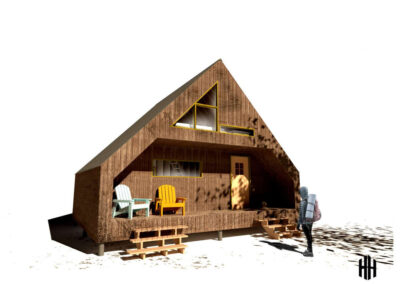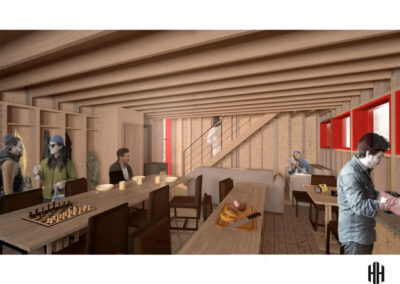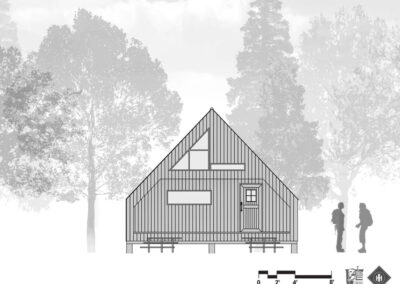By Matt Burnett
I have much enjoyed the opportunity to immerse myself in the centuries-old culture of hut-to-hut hiking in the Bavarian Alps for the past three years and my experiences there have given me cause to reflect on the similarities and differences between that special place and my home in Saranac Lake, located in the heart of New York State’s Adirondack Park. The Adirondacks and Bavaria are two places forged in great part by the mountains which are their bedrock – beacons of outdoor recreation known around the world, with people traveling from everywhere to climb the mountains, tour the Olympic history, and in many other ways enjoying the refuge of natural wilderness.
During a hike earlier this month in Germany’s Garmisch-Partenkirchen region, I took a few moments to reflect on the long established hut culture in Bavaria, the much younger “Forever Wild” culture of the Adirondack Park, and our efforts to merge existing Park resources towards a hut-to-hut model. We had hiked approximately four miles up along the gorge and reached our destination, the Hollentalanger Hutte. It was here that we put on dry shirts, sat at one of the numerous covered benches, and ordered our refreshments (which included, you guessed it, Radler—a delicious combination of helles, a German pale lager beer, and lemonade). Meanwhile, we discussed the day’s journey, other adventures and matters with the lightness of people who have invested a solid half day in the endeavor, reached a magnificent destination, and would be comfortably sleeping in beds that evening.
Having boots in both the Adirondacks and the German Alps has really shown me what is great about all of it, and that what transcends politics and history and shines through different locations and cultures is our shared appreciation of the rugged beauty of these places.
In February of 2019, Adirondack Hamlets to Huts (AHH) started a partnership with Norwich University’s Art and Architecture program. Five students (Mackenzie, Park, Emily, Nick, and Justin) came out to learn about our mission, explore the possibilities for one of our many “routes in development”, and eventually to collaborate on possible designs for our future huts.
Their teacher, Professor Matt Lutz, is an architect, colleague and friend of mine. As design educators with numerous years in the classroom, we both value the experience of service learning and collaborative/experiential learning to achieve our teaching goals—a priority that we share with the rest of the AHH Board of Directors and certainly its founders Joe Dadey and Jack Drury.
It doesn’t hurt that Matt and I have both spent many days paddling and hiking together in the Adirondacks with young people, so he knows well the culture of this region. Following a discussion in the fall 2018 of our mission and where we were at, Joe and Jack were pleased to host Norwich University in February 2019 towards the end of designing a basic hut that would meet the needs and address the restrictions of potential lodging on easement lands along a number of our planned routes.
Arriving in the heart of a snowy Adirondack winter, we put our guests straight to work. Following a brief overview at AHH headquarters with Jack and Joe about our mission and goals, Joe Dadey and I brought everyone to Chimney Mountain on the edge of the Siamese Ponds Wilderness Area. The purpose of this trip was to walk through some of the potential locations for future “huts” in this area. People coming in from the east would need a place nearby to stay, following or preceding a planned climb of Chimney Mountain. Some of the many variables that the students needed to factor in was the terrain, access, and several still unfolding possibilities for needed overnight accommodations in this area. The possibilities, which as of this date are still open, included a retrofit of an existing building, a stand-alone building, or a shared opportunity with some of the hunting camps positioned along nearby conservation easement lands.
As a twenty-year veteran of teaching art and design, I recognized early on how much hangs on the clarity of communication between the organization and the designers/students. In fact this is a big part of the learning process, which certainly does not end in college…how to get on the same page with the detailed, vague, and constantly evolving needs of the client in a building/design project. With the plethora of concerns that AHH is diligently and openly prioritizing, the trick was to give students as many specifics as possible while also giving them the broader picture of needs that would span many or all of our potential routes. For instance, a retrofit of an existing building is a much different problem than “from the ground up” new construction. A dedicated use of a structure is different from a shared use (one option being explored is the potential of utilizing private hunting lodges towards this purpose). Throughout our concentrated time together, Norwich students showed great professionalism, asking many questions, taking good notes and thoroughly engaging in the task at hand.
Our first day together in the field was very productive; not only were we scouting, we were doing, experiencing, exactly what our future AHH travelers will be experiencing. The students experienced the sweat from exertion and the need for cold-weather clothing and gear management that would get them to this shared destination. There were the typical thousand little details to consider and situations to navigate, matters in the field that are so real and become so important, such as how to dry boots and socks, replenish and distribute water, fix snowshoes, and find a wind-sheltered place to cook venison sliders, all the while keeping people safely warm and reasonably comfortable.
Following a late-afternoon hike of Chimney mountain, which yielded a stunning sunset in addition to cramped thighs and sore feet, we returned to Saranac Lake. Along the way, although feeling windswept and exhausted, we stopped at my hometown of Long Lake to have dinner at the Adirondack Hotel. It was a busy night here, with an open mic night and snowmobilers three deep at the bar. A busy night in an Adirondack hamlet in the middle of winter is not to be taken lightly; it is an occurrence that AHH seeks to help make more common. The opportunity for AHH trekkers to experience and connect with the wonderful, varied culture that exists in our rural communities is central to the overall Adirondack Hamlet-to-Hut experience. AHH can perhaps function best as a conduit, a broker for sharing the precious and special opportunities of our small places with those who want to immerse themselves in the whole Adirondack experience. As in Bavaria, an exhausting day on the trail can be a solo experience, but it doesn’t have to be; it can just as easily end in comfort and camaraderie. AHH aims to give people these options.
The following day, the design team visited the Adirondack Mountain Club’s Adirondack Loj on their way back to Vermont. The Adirondack Loj is perhaps one of the closest models to the mountain huts of Bavaria. The Adirondack Loj and Johns Brook Lodge are living examples of the shared-dormitory cultures that are a hold over from the early days of recreation in the Adirondacks. We looked at their bunkrooms and yurts, and talked about some of the history and culture of multi-day recreation in the Adirondacks. With lots of ideas, new friends and perhaps more than a few sore thighs from snowshoeing, students returned to Vermont to work on a hut design for AHH that reflected our needs, values and brand. Rather than designing specifically for one of our many locations, we prioritized instead a more generalized small structure that might work for several of our locations. Keeping within the 500 sq ft limit (which would be required at some locations), the challenge included how to provide sleeping space for 12 to 15, a kitchen, changing and common spaces, a porch and storage area.
Our dialogue continued through Mackenzie, the student project manager, via emails, phone calls and two online conference calls over the course of the semester. In the end, the students presented AHH with two excellent designs, complete with branding concepts, light and space analytics and laser-cut models for AHH’s use. The structures, named Beacon and Peak, both show the promise of AHH moving forward, of mixing the new with the old, of becoming the next link in the emerging culture of multi-day hut-to-hut hiking in the Adirondacks.
Our sincere thanks to Professor Lutz and all of our new colleagues for their hard work and creativity this year on this project.
Matt Burnett is a graphic and multimedia design professor at SUNY Canton and serves on the Adirondack Hamlets to Huts Board of Directors







